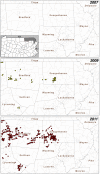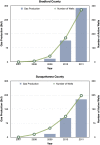Unconventional Gas and Oil Drilling Is Associated with Increased Hospital Utilization Rates
- PMID: 26176544
- PMCID: PMC4503720
- DOI: 10.1371/journal.pone.0131093
Unconventional Gas and Oil Drilling Is Associated with Increased Hospital Utilization Rates
Erratum in
-
Correction: Unconventional Gas and Oil Drilling Is Associated with Increased Hospital Utilization Rates.PLoS One. 2015 Aug 28;10(8):e0137371. doi: 10.1371/journal.pone.0137371. eCollection 2015. PLoS One. 2015. PMID: 26317358 Free PMC article. No abstract available.
Abstract
Over the past ten years, unconventional gas and oil drilling (UGOD) has markedly expanded in the United States. Despite substantial increases in well drilling, the health consequences of UGOD toxicant exposure remain unclear. This study examines an association between wells and healthcare use by zip code from 2007 to 2011 in Pennsylvania. Inpatient discharge databases from the Pennsylvania Healthcare Cost Containment Council were correlated with active wells by zip code in three counties in Pennsylvania. For overall inpatient prevalence rates and 25 specific medical categories, the association of inpatient prevalence rates with number of wells per zip code and, separately, with wells per km2 (separated into quantiles and defined as well density) were estimated using fixed-effects Poisson models. To account for multiple comparisons, a Bonferroni correction with associations of p<0.00096 was considered statistically significant. Cardiology inpatient prevalence rates were significantly associated with number of wells per zip code (p<0.00096) and wells per km2 (p<0.00096) while neurology inpatient prevalence rates were significantly associated with wells per km2 (p<0.00096). Furthermore, evidence also supported an association between well density and inpatient prevalence rates for the medical categories of dermatology, neurology, oncology, and urology. These data suggest that UGOD wells, which dramatically increased in the past decade, were associated with increased inpatient prevalence rates within specific medical categories in Pennsylvania. Further studies are necessary to address healthcare costs of UGOD and determine whether specific toxicants or combinations are associated with organ-specific responses.
Conflict of interest statement
Figures




References
-
- IER (2012) U.S. Leads World in Natural Gas Production from Hydraulic Fracturing. Available: http://instituteforenergyresearch.org/analysis/u-s-leads-world-in-natura....
-
- EIA (2014) EIA. Annual Energy Outlook 2014. Available: http://www.eia.gov/forecasts/aeo/mt_naturalgas.cfm.
-
- Lampe DJ, Stolz JF. Current perspectives on unconventional shale gas extxraction in the Appalachian basin. J Environ Sci Health. 2015; 50: 434–446. - PubMed
-
- Schnoor JL. Shale gas and hydrofracking. Environ Sci Technol. 2012; 46: 4686 doi: 10.1021/es3011767 - DOI - PubMed
-
- Earthworks. Earthworks Hydraulic Fracturing 101. Available: http://www.earthworksaction.org/issues/detail/hydraulic_fracturing_101#.....
Publication types
MeSH terms
Grants and funding
LinkOut - more resources
Full Text Sources
Other Literature Sources
Miscellaneous

